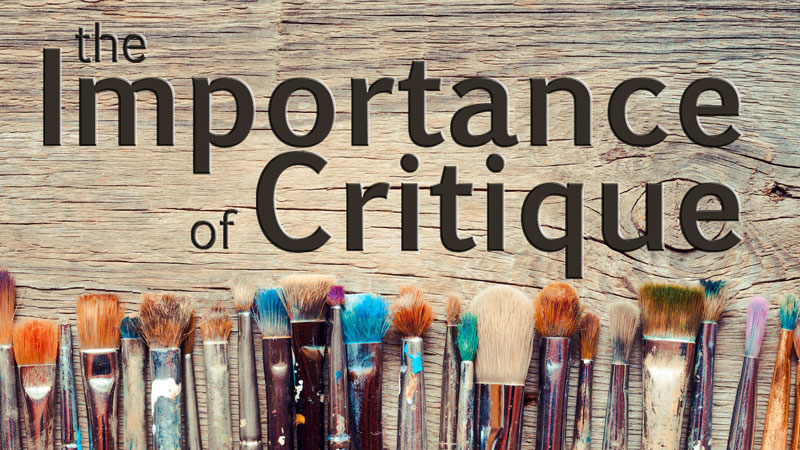
Actors need directors. When an actor acts, they clearly cannot see themselves. In their own mind, their actions and delivery may be flawless. However, the director can point out where their performance can be improved because the director sees the performance from the point of view of the audience. They can communicate to the actor how their actions and delivery are actually perceived by the most important factor in the theatre – the audience member.
As artists, we also need a second (or third) “set of eyes” on our work. We need to know how our work can be improved. We need to understand how our work is perceived by our audience – the viewer. Sometimes we can spot issues on our own, but most times we need input from others. This is where critique becomes an important part of our development as artists.
Critiques Should Not Be Scary
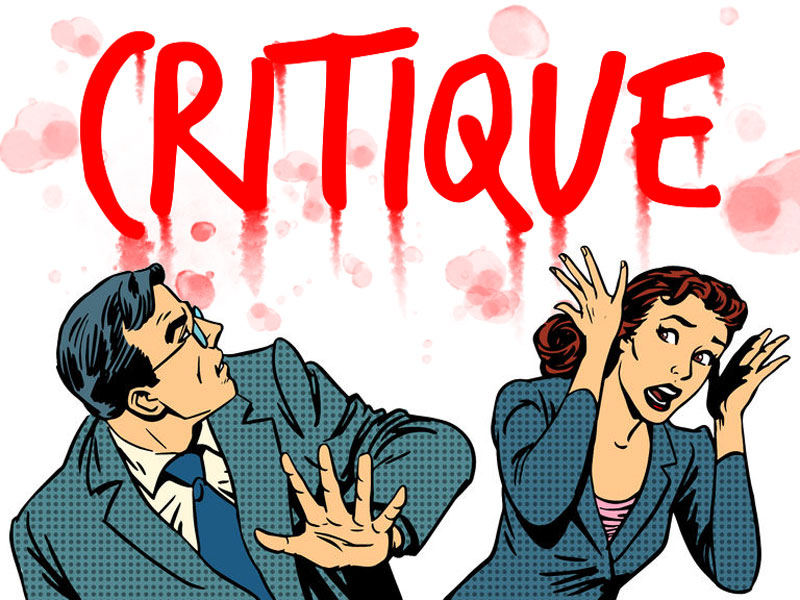
I still remember my very first critique in art school. It was scary. It shouldn’t have been, but it was. There I was, surrounded by my class and all of the focus was on my work. I still remember the room, where I was sitting, and even the smells.
It was a unique assignment. We were to create two non-objective paintings with acrylics. The first using just primary colors and values of those colors. The second painting was to be a copy of the first, but with just the neutral values of the colors. The goal was to match the values of the color painting exactly in the second attempt, just in neutral grays. So we ended up with two paintings, one in color and one in black and white.
My professor had a camera set up and a video screen to analyze the results. (This was 20 years ago and seemed like cutting edge technology, especially for a critique). The camera was positioned to shoot the easel and the video screen presented the shot in black and white.
Our color paintings were placed on the easel while the black and white versions were held up by the video screen. We were able to see our color painting in black and white and compare the results to our black and white painting right beside it. The point was to help us see how well we matched the values of the color painting in our black and white version.
For each one of us, he held our paintings up and compared them to the color versions presented in black and white.
It was finally my turn. My palms were soaked and my mouth was incredibly dry. I had never been this nervous before in my life.
As soon as my color painting was placed on the easel, I could see through the video screen just how poorly I had done. My values were way off. Even in areas that I thought I had filled in with solid applications, I saw discrepancies in the values. I was devastated. I even felt humiliated.
My professor pointed out the issues although they were already plainly visible on the screen. At the time, I felt like a failure. But looking back, I now know that this experience was one of the most important moments in my development as an artist.
You Are Not Your Work
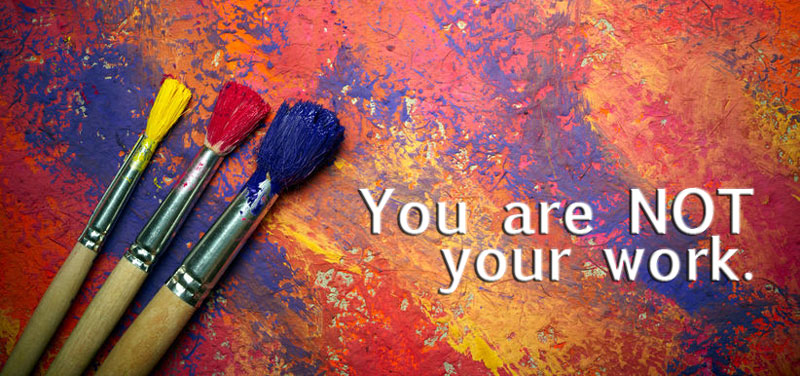
I felt like a failure, but it wasn’t me that needed work. It was the painting that needed more attention. Sure, I created the painting, but the painting wasn’t me. It was something that I produced as an artist, but it didn’t define who I was as an artist.
As artists, we create drawings and paintings and it’s often hard to separate ourselves from them. We pour so much of ourselves into them, that when they are critiqued, we feel that we are somehow being evaluated.
We must learn that our work is ultimately a product that we produce. As we better ourselves as artists, we produce better “products”. Critique can be painful at first, but if you understand that it is designed to result in a better product, then it becomes one of the most important activities in your artistic growth.
That critique, that I remember so vividly, taught me the importance of value. It was a lesson that I needed to learn and one that I may never have learned without the critique.
Getting Your Art Critiqued
I went on to experience many group critiques throughout my college years and even more after this period. As I became comfortable with the process of critique, I embraced it. I looked forward to the critique. Some of it was because I wanted to share what I created, but I also knew that I would learn something new. With every critique, I grew as an artist and what I produced became stronger.
Many of us don’t have the benefit of group critiques. We must rely on those that are close to us for feedback. Most of these folks don’t have a background in art and don’t want to chance hurting our feelings. As a result, we get “sugar-coated” responses that don’t really fit the definition of critique.
If you do have someone in your life who does have a bit of a background in art, then don’t hesitate to reach out to them and ask them for a critique every once in a while. Perhaps form a partnership with them and spend time sharing your work with each other.
If you don’t have one of these valuable people in your life, then look for other options. You can submit your work for critique in two ways on this very site…
- Submit your work on the forum – The forum has a very active group of passionate artists just like you that are more than willing to offer suggestions and feedback on your work.
- Submit your work to “The Member’s Minute” – The Member’s Minute is a weekly video that is produced for members that features a weekly critique and answers to your questions. Each week, I offer a detailed critique of a member-submitted art work. The critiques are recorded and shared with other members. So not only do you have a chance to have your work critiqued, but you can also learn from the critiques of others. (Access to The Member’s Minute requires membership.)
Critiquing Others
Not only is it important for us to experience critiques of our own work, but it’s also important to critique others. When we critique the work of others, we not only offer helpful suggestions but we also learn to find things that can be applied to our own work. We see how other artists solve problems and if their solutions are better than our own, we can borrow them. As a result, we all grow.
Critique should be specific and constructive. Those that are new to the process may offer generalized observations without supporting reasons or suggestions. Critique should be valuable to the artist, not just a list of problems with the work or vague compliments.
Here is a short list of some the comments inexperienced artists may offer in a critique…
- “I like it.”
- “I like your colors.”
- “It doesn’t look right.”
- “The face is wrong.”
- “I would buy that.”
These comments may be true, but they don’t offer any suggestions for the artist to improve the work. Instead, criticisms should be followed with suggestions or reasons that support the opinion.
Here is a list of hypothetical comments that would be more helpful…
- “I like it because you used the medium to its fullest potential and created a full range of value.”
- “I like your colors because you implemented a complementary color scheme.”
- “It doesn’t look right because the composition is too heavy with visual elements on the right side of the picture plane. You may try adding more elements on the left side to balance it out.”
- “The face is wrong because the eyes are proportionally too large compared to the other features. You may try making them a bit smaller.”
- “I would buy that because the emotive qualities of the work speak to me personally.”
Critique should always be approached with the artist in mind. It is to benefit them, not to belittle them or make them feel inferior.
Critique, in many ways, is crucial for artistic development. Don’t fear it, instead embrace what it can do for you.
If so, join over 36,000 others that receive our newsletter with new drawing and painting lessons. Plus, check out three of our course videos and ebooks for free.
Lesson Discussion
Comments are closed.


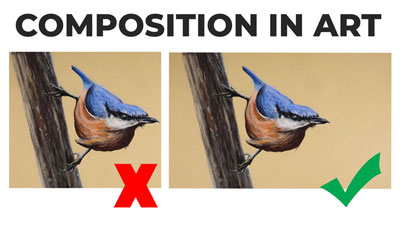

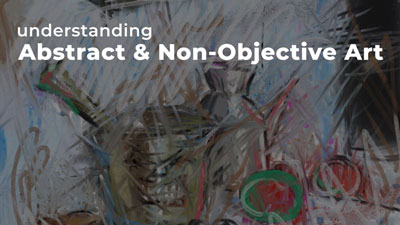
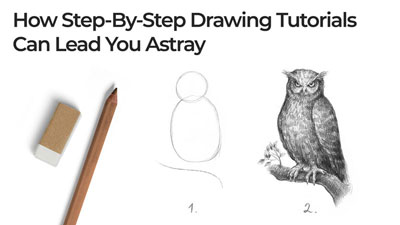
Both have some contrast to its type.
This is a great description of how critique is important to artists. I love the simplicity and how you approach the idea of critical observations, as well as the importance of pairing specific suggestions for improvement with them. The addition of your personal experience with your first critique could be particularly helpful to students who are preparing for/dreading their own first critique.